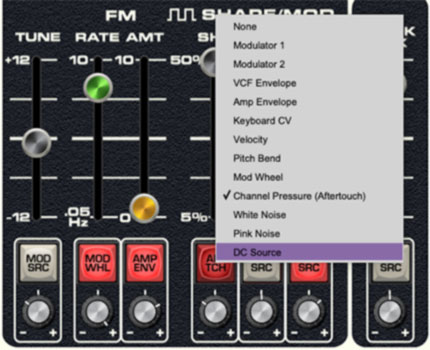
The original instrument had no user-configurable mod routing to speak of - all of its mod routings were fixed. It compensated for this shortcoming by including four LFO's, but still was fairly limited on the modulation front. Polymode improves upon modulation flexibility in two ways - we added two additional dedicated LFOs (for Rank 2 pulse-width modulation, and global mod of all three of the Resonators' cutoff frequencies), and significantly, we've added user-configurable mod assignments to almost every one of Polymode's variable synthesis parameters. Best of all, Polymode's mod assignments are super easy to use. Here's how they work:
The Mod Src selector buttons and attenuators beneath the sliders allow positive or inverted voltage control of the slider directly above via the selected mod source. Clicking the Mod Src selector button opens a pop-up menu where the mod source can be selected. Once a mod source is chosen, the button turns red and its label changes to indicate the current mod source. To choose a different mod source, click the button and choose another modulator, or choose None to disable modulation. The attenuator knobs beneath the Mod Src buttons set a positive or inverted voltage control amount for the controls, with center position representing zero modulation.
Note that the effect of incoming mod CV's is directly related to the current control position. For example, if the cutoff slider is currently set to fully open position, adding positive modulation will have no effect. In other words, modulation CV's can only alter a control setting within its inherent minimum and maximum settings.
Following is a list of all mod sources:
None: No mod source.
Modulator 1: The first LFO in the bottom section of the panel.
Modulator 2: The second LFO in the bottom section of the panel.
VCF Envelope: VCF envelope at the bottom of the panel. Keep in mind that the VCF envelope (as well as the VCF) is paraphonic; that is there is only one for the entire instrument, so it won't individually articulate for each note, but it does retrigger any time a key is pressed.
Amp Envelope: Amp envelope at the bottom of the panel. Unlike the VCF envelope, each note of polyphony has its own independent envelope generator.
Keyb CV: Generates a CV that rises as the keyboard is ascended. This a single voltage that "holds" at whatever CV was generated by the most recently played key. Try assigning Keyb CV to VCF Freq slider and raising the Master Gain VCF slider to clearly hear its effect.
Velocity: Generates a CV that changes depending on how hard the most recently played key was struck. Like Keyb CV, this is a single voltage that "holds" at its most recent value.
Pitch Bend: Generates a positive or negative CV depending on which way a MIDI pitch bender is moved.
Mod Whl: Generates a CV proportional to MIDI mod wheel movement.
Channel Pressure (Aftertouch): Generates a CV from keyboard aftertouch. (mono only)
White Noise: Though it doesn't appear on the panel, we hid a noise generator in Polymode as a mod source. Though it can't be used directly as an audio source, it's useful as mod source and works particularly for sound effects when routed to the Rank Tune sliders and VCF Freq slider.
Pink Noise: Similar to white noise, but with a slightly bassier frequency spectrum.
DC Source: This is a fixed voltage source that can be positive or negative dependent upon attenuator setting. This can be used to fully "open up" the VCF cutoff frequency. It's also useful for extending the mod depth of the Rank FM Amt sliders.